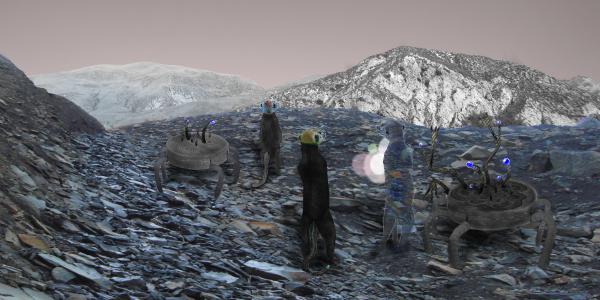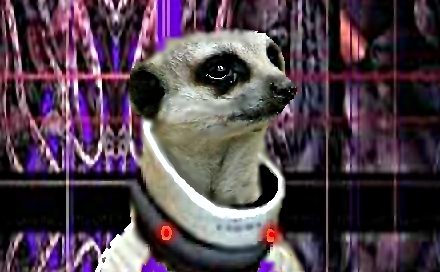BY LETTER
Tavi, Clade
Provolved clade largely derived from meerkats | |
 Image from PortalHunter | |
| A group of Tavis on vacation with their Faber associates on JD345768502-7 | |
The Tavi are a provolve/splice group of Terragen mammalian stock. Genetic analysis shows that the clade is derived primarily from the meerkats (Suricata suricatta) of Old Earth, but with significant additions of genetic material from other mongoose species, from humans, and from procyonids (raccoon, coati and kinkajou), as well as some strictly neogen sources. Tavi are rare in the Inner Sphere, but are well known on the Periphery of the Terragen sphere as early colonizers of new systems. They have been particularly common in the regions just beyond NoCoZo influence.
Physically, the Tavi are small slender humanoids. Standing digitigrade they are typically under 1.5 metres tall. They have clawed hands, prehensile tails, short snouts and large brown eyes with vertical pupils. Their black skin is covered in short greyish-brown fur over most of the body, but shows through near the hands, face, and feet. The fur itself varies from dense to sparse according to the ambient temperature over the past few weeks. Tavi prefer a high protein diet containing some chitin for roughage (comparable to their ancestral diet of lizards and small arthropods), but can subsist on a wide range of organics. They have a highly developed tactile sense and a surprisingly strong grip, and have a deft and delicate touch with intricate work. Though not particularly large or strong, they have very quick reflexes and are swift sprinters. They are excellent climbers and leapers, and are good at wriggling through confined spaces. They have a very keen and wide-ranging sense of smell. Tavi vision and hearing are somewhat comparable to that of the upper end for human nearbaselines subclades, with visual acuity and colour discrimination well above the human baseline norm and extra sensitivity to faint sounds. However their night vision is better due to their vertical pupils and the upper range of their hearing is higher by two full octaves. Their own language consists of high pitched chirps, barks, and trills, but their vocal range is very broad and they can communicate verbally with most terragen bionts.
All Tavi can grow or shed under-fur to adapt to the ambient temperature, and are able to see clearly in very dim to very bright light. They are capable of regenerating limbs without technical support and have a moderate degree of resistance to gamma and particle radiation and are strongly resistant to UV burns. Though they prefer habitats in the 25 to 35 °C range with a terran-standard mix of gases and standard terran gravity, they can tolerate varying temperatures in a broad range of oxygen bearing atmospheres, and they can survive indefinitely in anything from microgravity up to two terran gravities. Under adverse conditions Tavi are capable of placing themselves in long-term hibernation, reducing food and oxygen consumption to negligible levels. On the whole, they are physically tough and versatile creatures.
Living without medical support, Tavi have a natural life span of just under a century, though of course in civilized areas they can defer aging effects indefinitely. Their childhoods are short (sexually mature at 8 years, socially mature at 12), and they bear litters of 2 to 6 children at 6 month intervals. This gives the clade a powerful natural reproductive potential. However, socially subordinate individuals are not fertile, and when crowded or otherwise in sub-optimal conditions even the alpha pair in a Tavi social group does not bear any young.
Tavi are adaptable and imaginative, and have a strong sense of curiosity. They are quick and flexible though not particularly deep thinkers, and though they learn very quickly they have a very practical outlook and relatively short attention spans. Though individually they are not considered to be particularly intelligent overall (about the level of a baseline human), each one usually has one or more islands of brilliance (linguistics, programming, art, gene splicing, habitat design, combat, teaching, etc.). Their diverse talents and the fact that they are highly cooperative within their social groups makes them quite formidable collectively even if they are not very imposing as individuals. Tavi intuitions, innovations and kludges are famous. Tavi have a high need for excitement, and are aggressive both individually and as groups, though seldom to the point of physical violence. Even though their responses to their environment are quick and spontaneous, they are not usually long sustained. Though seldom actually rash or cowardly, Tavi are easily irritated or frightened by comparison with a typical human nearbaseline.
There are no known transapient entities of Tavi derivation. Since the Kedric Incident, most Tavi who attempt artificial self-improvement are regarded with extreme suspicion by the rest of the clade. Tavi have few lasting prejudices beside this, other than their present-day distrust of SI:2 entities. However, they are excitable and prone to political, legal and territorial disputes. They are good tacticians but poor strategists, and so are more often than not the losers in long term campaigns against patient or numerous opponents. Many sophonts regard them as clownish and bumptious half-provolved beings. Even where well-liked (some human nearbaselines think of them as "cute", especially in their heavily-furred cold weather form), they are not often highly regarded by a typical unsophisticated modosophonts.
The basic Tavi social unit is the "mob": an alpha male and female with 6 to 30 subsidiary non-reproducing adults, usually related, plus any children. The children are raised in community crèches. The subsidiary adults may, on occasion, divorce their mob and petition another group for entry, or may leave to form a new mob of their own. This most commonly happens between the ages of eight and fifteen, but adults of any age have been may do so at any time. More rarely, a displaced alpha pair will leave the primary mob with a few faithful hangers-on. Mobs cooperate as often as they compete, and occasionally form temporary nation-like, semi-democratic structures based partly on a hierarchy according to economic power and partly on one-mob-one-vote referenda. Where there are few immediate opportunities, a Tavi mob may remain stable for centuries. However, when a frontier opens up, mobs fragment and replicate as individuals and small groups strike out on their own and found new mobs. At times, the population growth rate can be alarmingly rapid.
 Image from Steve Bowers |
The Tavi are most often found at or beyond the fringes of Terragen civilization, where their alertness, innovation, and ability to deal with crises are most valuable. Scouting, exploration, and crisis management are areas in which they particularly excel. They typically discover and colonize a star system, terraform planets and construct habitats, and live there for several generations before a combination of Tavi restlessness and competition with later-arriving clades causes the majority to move on and colonize new areas (not before, of course, they have sold their existing holdings at a profit). Those who remain tend to be found in the "outback" of habitable planets, or on the less developed fringes of a system. Some Tavi mobs in the more highly settled areas are reclamation specialists who complete botched or marginal terraforming, fix damaged habitats, or clear systems that have been mined with the less sophisticated blights from autowars. In such cases, they tend to use the space they have created for a few generations, and then either by contract or impelled by pressure from later immigrants, sell their holdings and move on. A few collections of Tavi mobs have been "kept" in societums in the Utopia Sphere, but they are a difficult clade to maintain in this way, as they cannot thrive without new challenges and frontiers. Despite their reputation for simplicity, they can recognize attempts to manufacture artificial challenges for them.
Tavi mobs are commonly found in association with reprogroups of the vec clade Faber. Together the two clades can cover a wider range of habitats when they develop a new system, and in alliance, they are far more formidable when they deal with other clades than either of them might be individually, since their personalities and skills are complementary. Some Tavi mobs have integrated themselves into the Deeper Covenant, primarily in their specialty of colonization and reclamation. Together with Fabers they are often the first scouts and constructors for the beamrider network.
The precise origin of the Tavi is unknown. Their own records are of little use, as most mobs have a low regard for historical data unless some practical value is evident. The first mobs were recorded in the 5th millennium in the Utopia Sphere, but they quickly spread from that region, and the Utopia sphere may or may not have been their origin. Tavi are not particularly associated with any of the known Archailect driven civilizations, or allied with any of the major polities. It is commonly believed, even by the few speculative Tavi, that the entire clade was specifically designed to prepare new systems for Terragen settlement. Sapient grade conspiracy theorists often add that the Kedric Incident was designed to propel them even more quickly to the Periphery, so as to speed this process.
One of the few remains of the common Tavi heritage is a stylized crest with the motto "run and find out" in ancient Anglic. Such a motto, in one form or another, is known by nearly every known culture of the clade. The derivation of this appears to be a single tale by an Industrial Age fabulist named Kipling. This is the most likely clue as to the author(s) of the Tavi and their own culture, but no plausible candidates have yet emerged.
Related Articles
Appears in Topics
Development Notes
Text by Stephen Inniss
Initially published on 24 July 2004.
Initially published on 24 July 2004.






